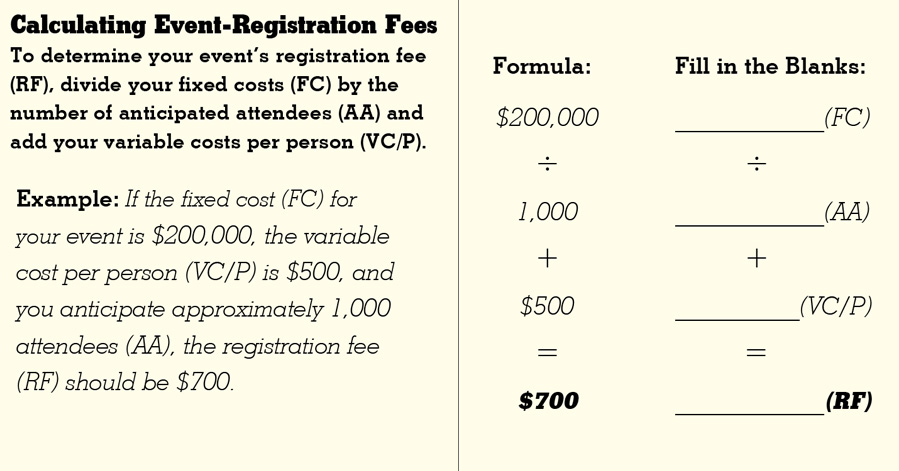|
exhibiting 101
 Event-Planning Primer
Planning an event entails much more than finding a venue and picking pretty details. Use these formulas and rules of thumb to ensure your next event goes off without a hitch.
As exhibit managers, we're often asked to take on additional
responsibilities. Early in my career, my former manager informed me that the company brass had decided to host a multiday conference for our international distributors and that I would be tasked with pulling it off. This would not only entail hotel site inspections, negotiating for room blocks and meeting space, and organizing a private trade show, but also planning a food and beverage (F&B) program, air and local transportation, and a slew of on-site social activities. I was an event-planning novice and needed to learn the ins and outs of the industry – and fast.
Thankfully, a benevolent hotel sales rep pointed me to a weeklong certificate program for meeting planners offered by a local university, where I learned the many guidelines, standards, and rules of thumb for staging corporate events. I'm happy to share what I learned during this course and as part of my preparation for the Certified Meeting Professional (CMP) exam sponsored by the Events Industry Council, but with the caveat that these tips and formulas aren't hard-and-fast rules. Every meeting and event is unique and should be treated as such. Space Configuration The amount of space your event needs will depend on the type of function you're hosting, the estimated number of attendees, and corresponding room layout, e.g., theater, classroom, banquet, or reception. ➤ Theater – Plan for 8 square feet per person if no audiovisual presentation is involved. If AV will be used, increase the space to 10 square feet per person. Theater setups allow you to pack the most people into the smallest space and are fine if attendees won't be taking a lot of notes and sessions are short. ➤ Classroom – Allot 12 square feet per person if you want three people per 6-foot table, or 18 square feet for two people per 6-foot table, allowing 44 inches between each row of tables. For classroom configurations with AV equipment, plan a minimum of 15 square feet per person. Classroom setups are better for longer training sessions or when people need adequate room to take notes. ➤ Banquet and Reception – Banquets and most receptions with a bar (or multiple bars) and standard buffet tables require 10 to 14 square feet per person. Banquet rounds are best for in-depth, small-group discussions, and they allow for quick room resets for food-focused functions. Food and Beverage Needs Having the right mix of bites and beverages is fundamental to keeping attendees happy and hydrated. Take these averages into account when placing your F&B order. ➤ Coffee, Tea, and Soda – Average consumption of beverages during a morning event will be approximately 65 percent hot (coffee and tea) and 35 percent cold (juice, iced tea, and soda). In the afternoon, beverage consumption will average about 65 percent cold and 35 percent hot. Coffee and hot water for tea are purchased by the gallon, which equals about 128 ounces and produces roughly 20 6-ounce cups. ➤ Snacks – Buy cookies, pastries, and brownies by the dozen rather than per person, as it's cheaper to buy in bulk. Or, if it's something that's individually wrapped, like granola bars or yogurt, buy on consumption. Alcohol Estimates While you certainly don't have to serve alcohol, it's common to have at least wine and beer on tap – especially at evening affairs. Consider these rules of thumb to help keep your attendees spirited, but not sloshed. ➤ Wine – A 750 milliliter (mL) bottle of wine contains 25.4 ounces. For each bottle of wine, you'll get about four-and-a-half 6-ounce servings, or five 5-ounce servings. ➤ Beer – A keg of beer holds 1,984 ounces, which equates to about 165 12-ounce servings. ➤ Liquor – A standard bottle of 80-proof distilled spirits (such as vodka, rum, gin, or tequila) holds 750 mL and pours approximately 17 1.5-ounce shots. If your bartender is using 1-ounce pours (known as a "short shot" or "pony shot"), a bottle will yield up to 25 drinks. To keep costs down (and drinks conservative), instruct your bartenders to use a measured shot glass rather than free pouring. Also negotiate to purchase liquor by the bottle rather than by the drink. It will be cheaper in the long run to buy the liquor for 20 to 25 drinks in one bottle rather than paying per drink – just like buying a keg of beer is cheaper per glass than buying individual bottles or cans. Agree up front with the catering manager on a system for auditing the used and unused bottles of liquor before and after the event to make sure you're only charged for what was consumed. In addition to these serving rules of thumb, consider the following stats regarding alcohol consumption, which typically varies depending on the environment in which it's served. ➤ Cash Bar – Average consumption for a one-hour party with a cash bar (where guests are purchasing their own drinks) is 1.5 drinks per person. While a cash bar might seem like a more cost-effective option for event planners since attendees are purchasing their own drinks, keep in mind that you are still responsible for the cost of the bar setup, the bartender, and possibly a bar-back helper.➤ Open Bar – Conventional wisdom will tell you that free drinks flow more, well, freely. And you're right. Average alcohol consumption at a one-hour "open" or "hosted" bar is 2 to 2.5 drinks per person. ➤ Reception – If you sponsor a post-conference reception with a cash bar, 50 percent of the crowd will stay for the reception, averaging about 1.5 drinks per person. If it's a hosted bar at a cocktail hour, 80 percent of the conference crowd will stay for the reception, consuming an average of 2.25 drinks per person in the first hour and 1.5 drinks in the second hour. Here again, you'll want to purchase sodas and beer on a consumption-only basis (rather than a per-person basis), paying only for the bottles and cans that are used. ➤ Dinner – If you're hosting a dinner, serve three bottles of wine (two white and one red) for each table of eight people, as one bottle of wine yields about five glasses. Below-the-Line Costs It's important to understand the below-the-line costs of your event, beyond the basic charges. You may be surprised to discover that up to an additional one-third of your bill comprises administrative fees, service charges, and mandatory gratuities, plus local and state taxes. ➤ Gratuities – A gratuity can be a tip or mandatory percentage of the basic charges. Depending on local tax laws, a gratuity may or may not be taxable. The way in which gratuity is distributed can be specified in your event contract with the venue. A rule of thumb for event-gratuity payments is 1.5 percent to 2 percent of the total event bill. You can have this amount added to your master account and distributed to preselected banquet and bar staff, or you can distribute it yourself to make sure the appropriate people receive it. 
➤ Tips – A tip is a small sum of money given voluntarily and directly to someone above and beyond a standard charge (often for performing
a service or task). Tips range from 15 percent for average service to 20 percent or more for exemplary service, and are awarded to waitstaff, housekeeping staff, and other service personnel at your discretion.
➤ Administrative Fees – Sometimes called a service charge or service fee, an administrative fee is an automatic and mandatory amount added to F&B charges by the service provider. It is typically calculated as a percentage of the total, and is usually used to help defray the cost of labor and equipment. Generally speaking, these charges will fall somewhere in the 18-percent to 25-percent range. Note that sometimes these administrative fees, taxes, and surcharges are not included in your quote. So ask if menus are available with "inclusive pricing," or pricing that includes both taxes and gratuity. If you see a "++" after the cost on a menu, it means "plus tax and plus gratuity." Also, ask what foods, beverages, and services are taxable and at what percentage. For example, some states and cities charge tax on alcoholic beverages, but not on food or nonalcoholic beverages. You'll want to know the figure on which your gratuity or service charge is based, as well. Possible Perks When negotiating perks with a venue, be prepared to answer questions about previous meetings you've planned, anticipated attendance, projected attendance at meal and beverage functions, the estimated number of room nights you'll require, and your space requirements for meeting rooms. Your leverage depends on all of those things, as well as the type of facility you're dealing with and the dates of your event. If you're planning your event when everyone else wants to be at that particular venue, it's "high season," which means higher prices. On the other hand, if your event occurs during a time of year when hurricanes or blizzards are common, it might be "off season," which translates to better overall pricing. Bottom line: If your event fills a gap in the venue's schedule, it will likely be more open to negotiating on other pricing. Regardless of when your event takes place, you can usually negotiate one complimentary room for every 35 to 50 cumulative room nights during your event. Stipulate in your contract that the total number of rooms used is cumulative through your entire event (not calculated daily), that it includes your guests' early arrivals and late departures, and that all rooms used by your group – regardless of how they were booked (e.g., through the internet or a travel agent) – count toward your total room count. You can also request staffers' rooms and speakers' rooms at a lower rate or with upgrades. Other negotiable perks include resort and health-facility use, complimentary cocktail parties, parking waivers, free business-center or internet use, complimentary airport transportation, and reductions or waivers for the cost of meeting rooms and exhibit space. By having these formulas and rules of thumb to reference, you'll be at the head of the class when it comes to planning and executing your company's next hospitality event. After all, knowledge is power. E  Candy Adams
Candy AdamsCTSM, CEM, CMP, CMM "The Booth Mom," is an independent exhibit project manager, trainer, speaker, consultant, and an Exhibitor Conference faculty member. CandyAdams@BoothMom.com
|
|
|
||||||||||||||||||||||||||||
|
|
||||||||||||||||||||||||||||
|
TOPICS Measurement & Budgeting Planning & Execution Marketing & Promotion Events & Venues Personal & Career Exhibits & Experiences International Exhibiting Resources for Rookies Research & Resources |
MAGAZINE Subscribe Today! Renew Subscription Update Address Digital Downloads Newsletters Advertise |
FIND IT Exhibit & Display Producers Products & Services All Companies Get Listed |
EXHIBITORLIVE Sessions Certification Exhibit Hall Exhibit at the Show Registration |
ETRAK Sessions Certification F.A.Q. Registration |
EDUCATION WEEK Overview Sessions Hotel Registration |
CERTIFICATION The Program Steps to Certification Faculty and Staff Enroll in CTSM Submit Quiz Answers My CTSM |
AWARDS Sizzle Awards Exhibit Design Awards Portable/Modular Awards Corporate Event Awards Centers of Excellence |
NEWS Associations/Press Awards Company News International New Products People Shows & Events Venues & Destinations EXHIBITOR News |
||||||||||||||||||||
|
||||||||||||||||||||||||||||






